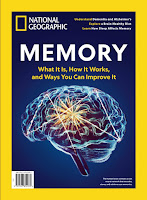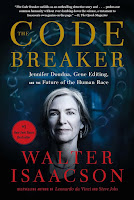Libros a explorar sobre las
complejidades que nos distinguen de las demás especies, primordialmente el
cerebro, la mente, el consciente y el inconsciente… en fin, lo que nos
hace humanos.
by Norman Doidge M.D.
An astonishing new science called "neuroplasticity" is overthrowing the
centuries-old notion that the human brain is immutable.
Although the book is fascinating, it’s my obligation to offer you a word of caution: It contains descriptions of experiments with animals, that could be disturbing for some readers (IAM).
by Leonard Mlodinow
Your preference in politics, the amount you tip your waiter—all judgments
and perceptions reflect the workings of our mind on two levels: the
conscious, of which we are aware, and the unconscious, which is hidden
from us.
by Dr. Michael Merzenich Ph.D.
Dr. Michael Merzenich--a world authority on brain plasticity--explains
how the brain rewires itself across the lifespan, and how you can take
control of that process to improve your life.
by Lewis Thomas
Lewis Thomas writes, "Once you have become permanently startled, as I am,
by the realization that we are a social species, you tend to keep an eye
out for the pieces of evidence that this is, by and large, good for
us."
by Michael Denton
If the cell somehow morphed into existence without the ability to
reproduce, it would also have been the last cell.
by David Eagleman
What does drug withdrawal have in common with a broken heart? Why is the
enemy of memory not time but other memories? How can a blind person learn
to see with her tongue, or a deaf person learn to hear with his skin?
Might we someday control a robot with our thoughts, just as we do our
fingers and toes? Why do we dream at night, and what does that have to do
with the rotation of the earth? The answers to these questions are right
behind our eyes.
by Norman Cousins
When Norman Cousins was diagnosed with a crippling and irreversible
disease, he forged an unusual collaboration with his physician, and
together they were able to beat the odds. The doctor's genius was in
helping his patient to use his own powers: laughter, courage, and
tenacity. The patient's talent was in mobilizing his body's own natural
resources, proving what an effective healing tool the mind can be. This
remarkable story of the triumph of the human spirit is truly inspirational
reading.
by Carl Zimmer
The fascinating, untold story of the air we breathe, the hidden life it
contains, and invisible dangers that can turn the world upside down.
Until 2020, scientists thought that respiratory diseases like Covid
spread through droplets.
by Siddhartha Mukherjee
Throughout, the story of Mukherjee’s own family—with its tragic and
bewildering history of mental illness—reminds us of the questions that
hang over our ability to translate the science of genetics from the
laboratory to the real world. In riveting and dramatic prose, he describes
the centuries of research and experimentation—from Aristotle and
Pythagoras to Mendel and Darwin, from Boveri and Morgan to Crick, Watson
and Franklin, all the way through the revolutionary twenty-first century
innovators who mapped the human genome.
by Joshua Foer
Foer's unlikely journey from chronically forgetful science journalist to
U.S. Memory Champion frames a revelatory exploration of the vast, hidden
impact of memory on every aspect of our lives.
On average, people squander forty days annually compensating for things
they've forgotten. Joshua Foer used to be one of those people. But after a
year of memory training, he found himself in the finals of the U.S. Memory
Championship. Even more important, Foer found a vital truth we too often
forget: In every way that matters, we are the sum of our memories.
by Tor Nørretranders
With foundations in psychology, evolutionary biology, and information
theory, Demark’s leading science writer argues a revolutionary point: that
consciousness represents only an infinitesimal fraction of our ability to
process information. Although we are unaware of it, our brains sift
through and discard billions of pieces of data in order to allow us to
understand the world around us. In this thought-provoking work,
Norretranders argues that our perceptions are not direct representations
of the world we experience, but instead, illusions our brains craft to
process it.
by Steven Pinker
One of the world’s leading cognitive scientists tackles the workings of
the human mind. What makes us rational—and why are we so often irrational?
How do we see in three dimensions? What makes us happy, afraid, angry,
disgusted, or sexually aroused? Why do we fall in love? And how do we
grapple with the imponderables of morality, religion, and consciousness?
How the Mind Works synthesizes the most satisfying explanations of our
mental life from cognitive science, evolutionary biology, and other fields
to explain what the mind is, how it evolved, and how it allows us to see,
think, feel, laugh, interact, enjoy the arts, and contemplate the
mysteries of life.
by Tula Karras
Whether it’s a recollection of a favorite meal or a pivotal childhood
experience, our brain preserves past moments, but scientists are still
unsure what exactly makes a memory. HOW MEMORY WORKS digs into the
connections our brains make and reveals what we’re still learning about
our own ability. Some highlights include: Profiles of people with
extraordinary memory capabilities, the regions of our brain vital to
memory retention, and detailed infographics mapping the process of
memory.
How is it that a three-pound mass of tissues and fats is known to be the
most complex of living structures? THE BRAIN dives into the control center
of the human body and explores the fascinating organ that sets the human
species apart. Some highlights include a look at the possible trillion
neurons that transmit information and coordinate physical activities, and
the latest imaging techniques that help us identify abnormalities and
disease.
by Walter Isaacson (2021)
Account of how Nobel Prize winner Jennifer Doudna and her colleagues
launched a revolution that will allow us to cure diseases, fend off
viruses, and have healthier babies.
When Jennifer Doudna was in sixth grade, she came home one day to find
that her dad had left a paperback titled The Double Helix on her bed. She
put it aside, thinking it was one of those detective tales she loved. When
she read it on a rainy Saturday, she discovered she was right, in a way.
As she sped through the pages, she became enthralled by the intense drama
behind the competition to discover the code of life. Even though her high
school counselor told her girls didn’t become scientists, she decided she
would.
by Matt Ridley
The genome's been mapped. But what does it mean? Matt Ridley’s Genome is
the book that explains it all: what it is, how it works, and what it
portends for the future
“Ridley leaps from chromosome to chromosome in a handy summation of our
ever increasing understanding of the roles that genes play in disease,
behavior, sexual differences, and even intelligence. . . He
addresses not only the ethical quandaries faced by contemporary scientists
but the reductionist danger in equating inheritability with
inevitability.” — The New Yorker
by Oliver Sacks
Oliver Sacks’s The Man Who Mistook His Wife for a Hat tells the stories
of individuals afflicted with fantastic perceptual and intellectual
aberrations: patients who have lost their memories and with them the
greater part of their pasts; who are no longer able to recognize people
and common objects; who are stricken with violent tics and grimaces or
who shout involuntary obscenities; whose limbs have become alien; who
have been dismissed as retarded yet are gifted with uncanny artistic or
mathematical talents.
by Oliver Sacks
In Musicophilia, [Dr. Sacks] shows us a variety of what he calls
“musical misalignments.” Among them: a man struck by lightning who
suddenly desires to become a pianist at the age of forty-two; an entire
group of children with Williams syndrome, who are hypermusical from
birth; people with “amusia,” to whom a symphony sounds like the
clattering of pots and pans; and a man whose memory spans only seven
seconds-for everything but music.
by Matthew Walker
Within the brain, sleep enriches a diversity of functions, including our ability to learn, memorize, and make logical decisions. It recalibrates our emotions, restocks our immune system, fine-tunes our metabolism, and regulates our appetite. Dreaming creates a virtual reality space in which the brain melds past and present knowledge, inspiring creativity.
XX. ELASTIC: UNLOCKING YOUR BRAIN'S ABILITY TO EMBRACE CHANGE – JANUARY 8, 2019
by Leonard Mlodinow
In this startling and provocative look at how the human mind deals with change, Leonard Mlodinow shows us to unleash the natural abilities we all possess so we can thrive in dynamic and troubled times. Truly original minds capitalize when everyone else struggles. And most of us assume that these abilities are innate, reserved for a select few. But Mlodinow reveals that we all possess them, that we all have encoded in our brains a skill he terms elastic thinking—and he guides us in how to harness it.
XXI. LEER LA MENTE: EL CEREBRO Y EL ARTE DE LA FICCIÓN – APRIL 18, 2011
by Jorge Volpi
Un brillante y provocador ensayo, donde Jorge Volpi entrelaza ciencia y literatura y demuestra que todos somos ficciones y que la literatura es una de las claves de nuestra identidad individual y nuestras pasiones compartidas. ¿Qué pasa en mi cerebro cuando leo una novela o un cuento?¿Cómo y cuándo aparecieron?¿Qué parte de la mente inventa las anécdotas felices o los desenlaces trágicos?¿Por qué sufrimos o gozamos con los personajes de los relatos y de qué forma nosotros, los lectores, nos transformamos en esos personajes?¿No es acaso el yo nuestra mayor invención? En este brillante y provocador ensayo, Jorge Volpi destierra la vieja idea de la ficción como entretenimiento y sostiene, por el contrario, que las novelas y los cuentos han sido esenciales para la evolución de la especie humana.
BLOG
Recopilación por Isaias Ferreira Medina























No hay comentarios.:
Publicar un comentario